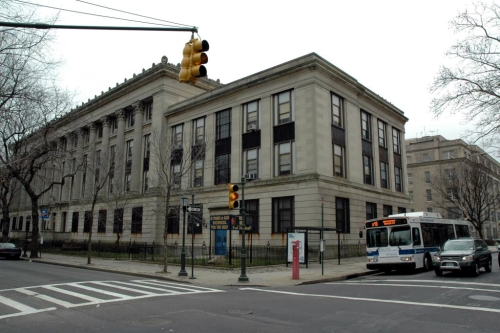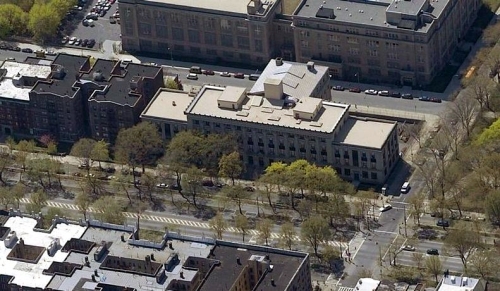Building of the Day: 260 Eastern Parkway
Brooklyn, one building at a time. Name: Originally Bishop McDonnell Memorial HS for Girls, now St. Francis De Sales School for the Deaf Address: 260 Eastern Parkway Cross Streets: Corner Classon Avenue Neighborhood: Crown Heights South Year Built: 1924-1925 Architectural Style: Beaux Arts Architect: Robert J. Reiley Other Work by Architect: Keating Hall, Fordham University,…

Brooklyn, one building at a time.
Name: Originally Bishop McDonnell Memorial HS for Girls, now St. Francis De Sales School for the Deaf
Address: 260 Eastern Parkway
Cross Streets: Corner Classon Avenue
Neighborhood: Crown Heights South
Year Built: 1924-1925
Architectural Style: Beaux Arts
Architect: Robert J. Reiley
Other Work by Architect: Keating Hall, Fordham University, Bronx; Cathedral High School, James Weldon Johnson Houses, St. Clare’s Hospital, all Manhattan. Many other churches, schools, hospitals, seminaries, housing across the United States.
Landmarked: No
The story: The area around the Brooklyn Museum gets claimed by many neighborhoods, but it belongs to my old neighborhood, Crown Heights. Eastern Parkway is especially wide and beautiful here, and after the museum was established, it was really a no-brainer that the surrounding area would be filled up soon. By the end of the 1920s it was filled up, with parkland and the Botanical Gardens, and a mixture of apartment houses, schools and other civic structures. The apartments ended up opposite the museum, while the schools and gardens line the street alongside McKim, Mead & White’s classically inspired masterpiece. These were really big buildings that could hold their own near the massive museum, and they form a very interesting neighborhood.
Back in the old days, it seems that more architects understood that their work did not stand alone, it stood with neighbors. It would be impossible, as well as rather crass, to try to compete with the museum just to satisfy an architect’s ego, and as the structures rose around it, most did not even try. Instead, they chose to complement the museum. The Catholic Church, the largest growing denomination in Brooklyn, needed a new girl’s school. This fast developing area was perfect for it; it was in the middle of a very Catholic part of town, with a large Irish and Italian Catholic population. Eastern Parkway still had a lot of empty land, and the museum area was well represented with public transportation. The new school to be built next door to the museum would complement it in every way.
The diocese went with Manhattan’s premiere architect doing work for the Church at this time. Robert J. Reiley had a Catholic education, followed by a degree in architecture from Columbia. He worked for prominent early 20th century architects like Ernest Flagg and Van Vleck and Goldsmith before travelling around Europe, and returning to open his own practice. He soon become the Dioceses of New York’s go-to architect, designing dozens of churches, schools, hospitals, convents and other church related buildings.
He’s responsible for Keating Hall, on the Fordham campus, St. Clare’s Hospital in Manhattan, now closed, and Our Lady of Angels, in Coney Island. He also has a long list of churches and related buildings in New York, New Jersey and elsewhere. He partnered with Gustave Steinbeck, another highly regarded Catholic Church architect, for many years, and much later, partnered with his sons. His long career has an impressive list of buildings, in many styles and materials.
This school, Bishop McDonnell Memorial High School for Girls, was known by students as “Bishop”, its student body was dubbed the “Memorialites,” and they were open for business in September of 1926. It is a huge 94,000 square foot building that stretches down Eastern Parkway. The Church was fortunate to get the land, instead of having to build up. Art Deco was quite in vogue at this time, but Reiley chose the classical lines of the museum as his inspiration, and made them his, stretching his building, as the museum is stretched, with graceful columns and Beaux-Arts details. It’s really a fine building in all ways, quite complements its neighbor, and sits beautifully on the street.
The large school served Catholic girls from all over the area, including Park Slope and Flatbush, although for many, many years, there were no African-American or other non-white girls visible in their yearbooks, many of which are available to see online. The school was scholarship only, with no tuition until the 1960s. By then, minorities in the student and teaching staff slowly begin to appear in their literature. But the Catholic exodus to the suburbs had begun, and by 1973, the decision had been made to close Bishop. The last graduating class left the halls that year, with the other students transferring to other schools, or out of the system.
The church turned the building over to teaching of the deaf. It is now the St. Francis De Sales School for the Deaf, which offers pre-school up through 8th grade education. The school also has programs for the deaf community, social and medical services, signing classes and clinical support for the deaf. It seems the school was chosen to be landmarked in 1980, but it did not go through. GMAP
(Photo: Nicholas Strini for Property Shark)






What's Your Take? Leave a Comment